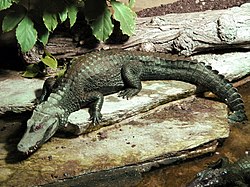| Paleosuchus Temporal range: Late Pleistocene - Recent, | |
|---|---|
 | |
| Paleosuchus palpebrosus | |
| Scientific classification | |
| Domain: | Eukaryota |
| Kingdom: | Animalia |
| Phylum: | Chordata |
| Class: | Reptilia |
| Clade: | Archosauromorpha |
| Clade: | Archosauriformes |
| Order: | Crocodilia |
| Family: | Alligatoridae |
| Subfamily: | Caimaninae |
| Genus: | Paleosuchus Gray, 1862 |
| Species | |
Paleosuchus is a South American genus of reptiles in the subfamily Caimaninae of the family Alligatoridae. They are the smallest members of the order Crocodilia in the Americas. [2]



